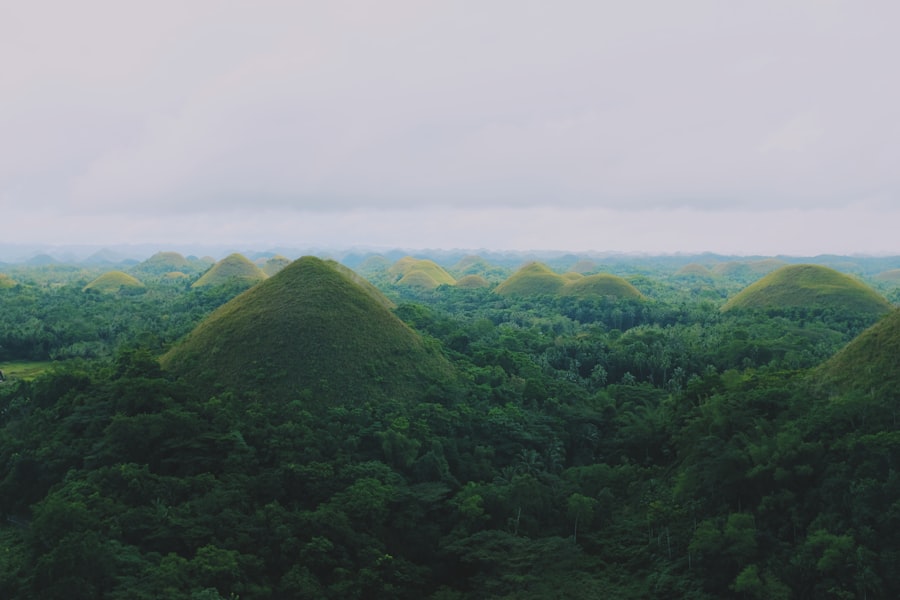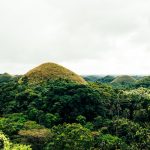Download links
How to install Exploring the Magnificent Chocolate Hills in fb777 APK?
1. Tap the downloaded Exploring the Magnificent Chocolate Hills in fb777 APK file.
2. Touch install.
3. Follow the steps on the screen.
Description
The Chocolate Hills, a geological wonder located in the Bohol province of the Philippines, are a striking natural phenomenon that has intrigued scientists and tourists alike. These hills, numbering over 1,200, rise dramatically from the surrounding landscape, creating a unique and captivating sight. The formation of these hills is attributed to a combination of geological processes that took place over millions of years.
Primarily, they are composed of limestone, which was formed from the remains of marine organisms that settled on the ocean floor during the Pleistocene epoch. Over time, tectonic activity caused the land to uplift, exposing these limestone deposits. The distinctive conical shapes of the Chocolate Hills are the result of erosion.
Rainwater, along with the region’s tropical climate, has played a significant role in sculpting these hills. The process of weathering has gradually worn away softer materials, leaving behind the more resistant limestone formations. During the dry season, the grass that covers these hills turns a rich brown color, giving them their name.
This seasonal transformation adds to their allure, as visitors can witness the hills’ appearance change dramatically throughout the year. The Chocolate Hills are not only a testament to the power of natural forces but also serve as a reminder of the Earth’s dynamic history.
Key Takeaways
- The Chocolate Hills were formed by the uplift of coral deposits and the action of rainwater and erosion over millions of years.
- Visitors can enjoy breathtaking panoramic views of the 1,268 cone-shaped hills from viewing decks and observation points.
- The area is home to a diverse range of flora and fauna, including rare orchids, butterflies, and the endangered tarsier.
- Tourists can engage in activities such as hiking, zip-lining, and ATV rides, and visit nearby attractions like the Chocolate Hills Adventure Park.
- The Chocolate Hills hold cultural and historical significance for the local community, with legends and folklore surrounding their formation.
- Conservation efforts are underway to protect the natural beauty and biodiversity of the Chocolate Hills, ensuring their preservation for future generations to enjoy.
Breathtaking Views and Landscapes
The vistas offered by the Chocolate Hills are nothing short of breathtaking. From various vantage points, visitors can gaze upon rolling hills that stretch as far as the eye can see, creating a mesmerizing landscape that seems almost otherworldly. The most popular viewpoint is located at the Chocolate Hills Complex in Carmen, where an observation deck allows for panoramic views of this stunning terrain.
Standing atop this vantage point, one can appreciate the undulating hills that rise and fall like waves on an ocean, creating a sense of tranquility and wonder. The surrounding environment enhances the beauty of the Chocolate Hills. Lush greenery envelops the base of the hills, contrasting sharply with the brown peaks during the dry season.
The interplay of light and shadow across the landscape adds depth and dimension to photographs taken in this area. As the sun sets, the hills are bathed in golden hues, creating a magical atmosphere that captivates all who witness it. The combination of natural beauty and serene surroundings makes the Chocolate Hills a must-visit destination for nature lovers and photographers seeking to capture the essence of this unique landscape.
Flora and Fauna in the Chocolate Hills

The biodiversity found within and around the Chocolate Hills is as remarkable as their geological features. The region is home to a variety of plant species that thrive in its unique environment. Grasses dominate the landscape, particularly during the dry season when they turn brown, but several other plants also contribute to the area’s ecological richness.
Among these are endemic species that have adapted to the limestone soil and tropical climate, showcasing nature’s resilience and adaptability. In addition to its diverse flora, the Chocolate Hills are also a habitat for various animal species. Birds are particularly abundant in this region, with numerous species taking advantage of the open spaces and rich vegetation.
The hills provide nesting sites and feeding grounds for these avian inhabitants. Additionally, small mammals and reptiles can be found in this ecosystem, contributing to its ecological balance. The presence of such wildlife highlights the importance of preserving this unique environment, as it supports not only plant life but also a complex web of animal interactions.
Activities and Attractions in the Area
| Activity/Attraction | Description | Location | Opening Hours |
|---|---|---|---|
| Beach | Relax on the sandy shores and enjoy water sports | Coastal area | 24/7 |
| Hiking Trails | Explore scenic trails through the mountains | Mountainous area | Daylight hours |
| Historical Sites | Visit ancient ruins and learn about local history | Various locations | 10am – 5pm |
| Amusement Park | Enjoy thrilling rides and family-friendly attractions | City center | 10am – 8pm |
Visitors to the Chocolate Hills can engage in a variety of activities that enhance their experience of this natural wonder. Hiking is one of the most popular pursuits, with several trails winding through the hills and offering different perspectives on their beauty. These trails vary in difficulty, catering to both casual walkers and more adventurous trekkers.
Along these paths, hikers can immerse themselves in the lush surroundings while enjoying breathtaking views at every turn. In addition to hiking, visitors can partake in ATV rides that provide an exhilarating way to explore the terrain. These guided tours allow adventurers to navigate through rugged paths and experience the hills up close.
For those seeking a more leisurely experience, there are opportunities for photography and picnicking in designated areas where one can relax and soak in the scenery. The Chocolate Hills Complex also features educational exhibits that provide insights into the geological formation and cultural significance of this iconic site.
Cultural and Historical Significance
The Chocolate Hills hold cultural significance for the local communities in Bohol. They are steeped in folklore and legend, with various stories passed down through generations that explain their origin. One popular tale involves giants who engaged in a fierce battle, resulting in large mounds being left behind as remnants of their conflict.
Such narratives enrich the cultural tapestry of Bohol and contribute to a sense of identity among its residents. Historically, the Chocolate Hills have also played a role in attracting tourism to Bohol, significantly impacting the local economy. As awareness of this natural wonder has grown, so too has its importance as a tourist destination.
The influx of visitors has led to increased investment in infrastructure and services in nearby towns, fostering economic development while also raising awareness about environmental conservation efforts necessary to protect this unique landscape.
Conservation Efforts and Future of the Chocolate Hills

Preserving the Geological Integrity and Ecological Health
As interest in the Chocolate Hills continues to grow, so does the need for effective conservation efforts to protect this natural treasure. Local government units and environmental organizations have initiated programs aimed at preserving both the geological integrity and ecological health of the area. These initiatives include reforestation projects that aim to restore native vegetation around the hills, which helps prevent soil erosion and supports local wildlife habitats.
The Role of Education in Conservation
Education plays a crucial role in conservation efforts as well. By raising awareness among visitors about responsible tourism practices and the importance of preserving natural resources, stakeholders hope to foster a culture of sustainability within tourism activities.
Striking a Balance between Tourism and Conservation
The future of the Chocolate Hills depends on striking a balance between promoting tourism and ensuring that this unique landscape remains intact for generations to come. As conservation efforts continue to evolve, there is hope that this iconic site will not only retain its beauty but also serve as an enduring symbol of nature’s resilience and humanity’s commitment to protecting it.
If you’re interested in exploring more about photography and editing, you may want to check out the article on “Pip Camera – Editor de Fotos 1.5” on fb777.best. This article discusses a photo editing app that can enhance your pictures and add creative effects. It’s a great tool to use for capturing and editing stunning images, just like the breathtaking views of the Chocolate Hills. Click here to read more about it.
FAQs
What are the Chocolate Hills?
The Chocolate Hills are a geological formation in the Bohol province of the Philippines. They are made up of around 1,268 cone-shaped hills, which are covered in green grass that turns brown during the dry season, giving them the appearance of chocolate kisses.
How were the Chocolate Hills formed?
The exact formation process of the Chocolate Hills is still a subject of debate among geologists. However, it is widely believed that they are the result of the uplift of coral deposits and the action of rainwater and erosion over millions of years.
What is the best time to visit the Chocolate Hills?
The best time to visit the Chocolate Hills is during the dry season, which typically runs from late November to May. This is when the grass covering the hills turns brown, giving them their chocolate-like appearance.
Are there any activities to do at the Chocolate Hills?
Visitors to the Chocolate Hills can enjoy activities such as hiking, zip-lining, and ATV (all-terrain vehicle) rides. There are also viewing decks and platforms that offer stunning panoramic views of the hills and the surrounding countryside.
Is there an entrance fee to visit the Chocolate Hills?
Yes, there is an entrance fee to visit the Chocolate Hills. The fee helps with the maintenance and preservation of the area.





